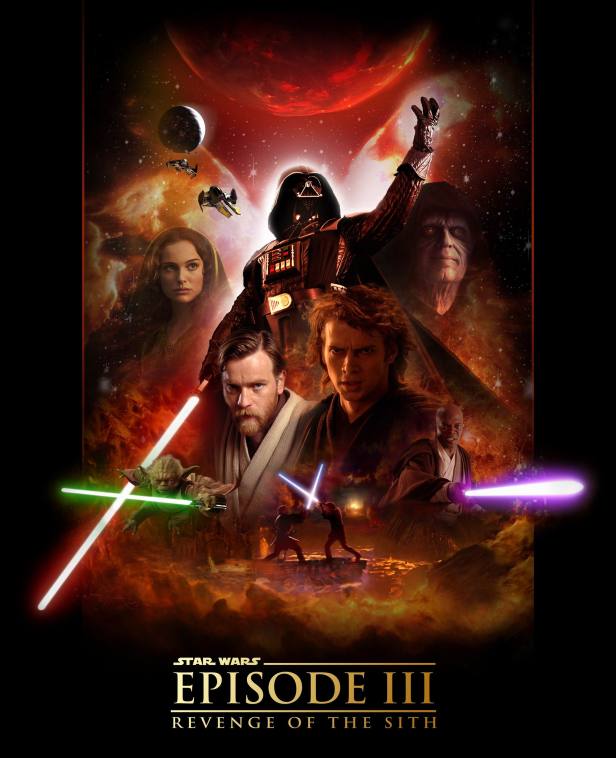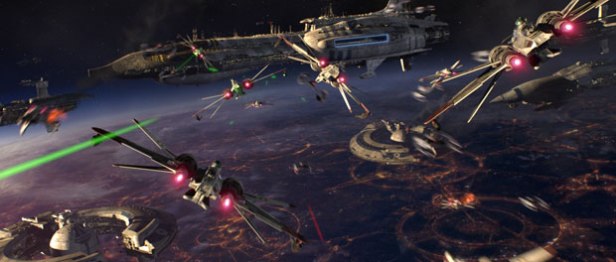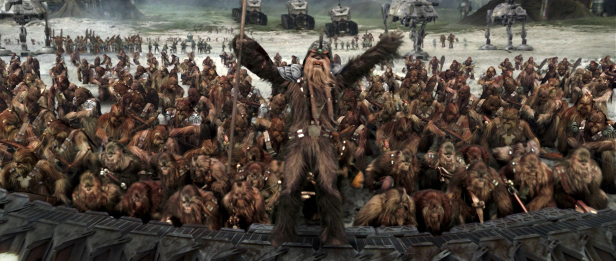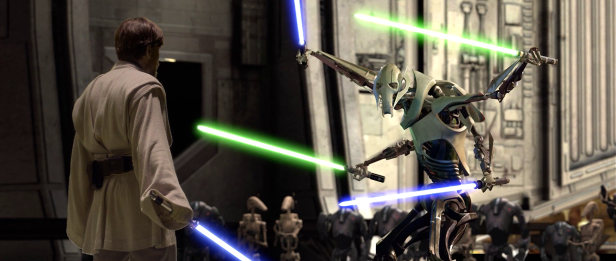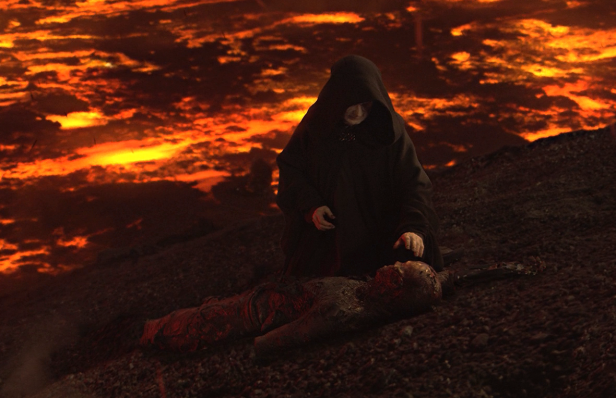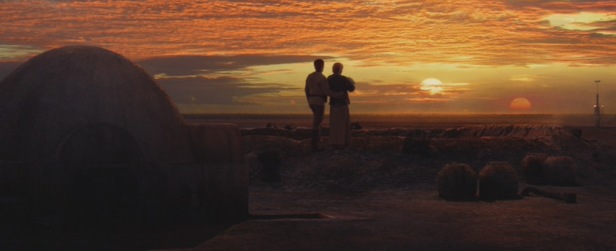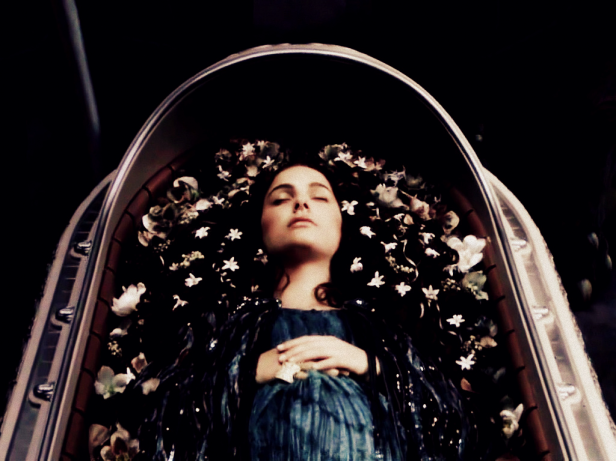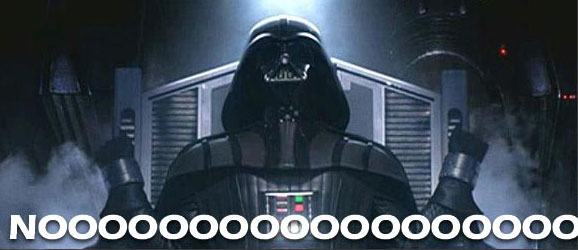Resident musicologist Max DeCurtins throws some intergalactic shade at Revenge of the Sith, with a special side-eye reserved for the upcoming J.J. Abrams property.
Few things speak to my childhood—or to my adulthood—as directly as Star Wars. Ironically, I don’t even remember when or where Star Wars entered my life; I know only that I was very young. In fact, I hardly watch the movies of the Original Trilogy anymore for their own sake; I often throw them on in the background as I write code, send e-mails, browse the Web, and do other things. They have become what my best friend calls “sewing movies”: movies that you know and love so dearly that you put them on to keep you company while sewing ballroom dresses, theatre costumes, or everyday wear—often into the wee hours of the morning because that’s when the world finally stops bothering you for a while. Like all good sewing movies, they still seem—amazingly, even miraculously—fresh even after many years and countless viewings.
Star Wars doesn’t make me nostalgic for my childhood, but as a child it provided me with a world far more interesting than the one in which I would go to elementary school or middle school and very much not be part of the social circles to which everyone else ostensibly belonged. In fact, I believe that my eighth-grade yearbook, making the “Where will they go?” predictions whose true authors no one ever knows, portends that I will feature in my very ownStar Wars movie. Thanks, mystery yearbook authors. I’m sure the folks at Lucasfilm (no, sorry, Disney) are hunting down my contact information as we speak.
By now it should be clear that I am an unapologetic devotee of the Original Trilogy—and onlythe Original Trilogy. I sometimes think it’s a hard position to defend in our era of calling out ideological attitudes. Like “authentic,” though perhaps less tainted, the word “original” presents its own problems of interpretation. In my usage, we are talking about what took us from a world without Star Wars to a world with Star Wars; for me, therefore, the “Original Trilogy” refers to the theatrical versions of Episodes IV, V, and VI—THX re-mastered or not—that do not contain any of George Lucas’ edits of the late 1990s. They are the material that won over legions of fans before anything else appeared in the Star Wars universe. Yes, I have seen the Prequels. Yes, long ago I read quite a number of the mass-market paperbacks. They have something vaguely Star Wars-ish about them. (They have also probably quadrupled or quintupled in number since I was a kid and would wait in agony for them to be returned to the library so I could check them out and read them.) But in the end, they’re not sewing movies.
I first saw Revenge of the Sith with some Hillel groupies at the Camino Real Marketplace Cinema on Storke Road. It’s vaguely possible that a few of our cohort came along not because Star Wars meant anything to them, but because we may have promised them McConnell’s ice cream after the movie. Because priorities. After all, it was about to be summer in Santa Barbara, and May is just about the most gorgeous month of the year there. I know that I went into that theater not quite knowing what to expect; at the time, nobody had reason to believe that any more Star Wars movies would ever get made, and rumor had it that Sith supposedly packed more punch than its predecessors. This was the Prequel Trilogy’s last chance at redemption. Still, I had seen Episodes I and II, and with a physicist for a father, I knew that there was a certain momentum that would take much force—no pun intended—to overcome. When I walked out of that theater, I definitely walked out feeling just about as conflicted as I’ve ever felt after seeing any movie before or since. Ten years later, this is still basically the case.
I have seen people try to pretend that Episodes II and III fare a little better than Episode I.
No.
They are all terrible. Episode III is exactly as bad as Episodes I and II. If you didn’t know any better, and had learned about Star Wars by watching the Prequel Trilogy first, you’d think that Episode IV was titled “A New Hope” because, after Episode III, you’d be pretty devoid of hope that the series would get any better.
Revenge of the Sith starts with a battle in the space above Coruscant. For a moment, the music vanishes and all we get is an epic shot of a battle accompanied by the stark sound of unpitched drums. For a moment, it’s genuinely unnerving, but then, alas, the movie begins in earnest. Anakin and Obi-Wan, piloting the fighters that clearly will become Imperial TIE fighters by the time of the Original Trilogy, struggle to reach the flagship of General Grievous (clever name, George!), who holds Chancellor Palpatine prisoner aboard.
First things first: Palpatine has orchestrated his own capture by the Separatists. We’ve known all along throughout the Prequel Trilogy that Palpatine will eventually become the Emperor, and no fucking self-respecting Dark Lord of the Sith just rolls over when an armed insurrection comes to fuck with him. He’s placid as a stoner when Anakin and Obi-Wan show up to rescue him, and let’s not miss the fact that he’s CUFFED TO A FUCKING THRONE.
Anakin and Obi-Wan return to Coruscant with Palpatine, whereupon Anakin immediately goes all angst-ridden on Padmé, who’s just revealed that she’s pregnant with his Jedi-babies; yet what captures our attention? The buns. SHE’S WEARING THE FUCKING PRINCESS LEIA BUNS. Let me tell you, Oedipal relationships do not improve with the addition of Princess Leia buns. That’s a fact, kids.
After dreaming that Padmé dies in childbirth, Anakin seeks out a little therapy—from Yoda. The exchange is pedestrian, peppered with tired invocations of “death is a part of life” and “let go.” It’s a good thing there’s no Star Wars equivalent of Blue Cross Blue Shield; if I got that shit in a session, I’d ask for my fucking money back and have to fight the insurance company for the check. In the Original Trilogy, Yoda never functioned as a therapist…or a lot of other things, for that matter. Yoda has, for a lot of people, I suspect, but also for me, always hewed a little closer to Mr. Miyagi than to Sigmund Freud. He trained Luke; he taught Obi-Wan. And he spent basically all of his time in Empire Strikes Back telling Luke to quit being a fucking whiner baby. He didn’t analyze anybody or fight fancy lightsaber duels. If we have to see Yoda as psychotherapist, I guess the next logical question to ask would be: is Yoda an in-network specialist?
Boys and girls, it’s time to talk about hypercorrection.
Many of the authors contributing to this distinguished blog hail, as I do, from an academic background, and we all know that person—in a seminar or at a conference—who tries to make whatever they say sound more sophisticated than it is, who submits to the urge to lace their contribution with academic terminology they don’t fully understand, who attempts to emulate the tenured faculty in the room…and ends up tripping over themselves. Linguists call this phenomenon “hypercorrection”—taking a phonological or grammatical rule or quirk too far, and ending up with an ungrammatical form. Sociologists have identified a similar phenomenon in social behavior (for example, imitating the visible habits of the social class above one’s own, but missing the nuances that come only with membership in that class).
R2-D2, C-3PO, Yoda, and Palpatine all exhibit a high degree of hypercorrection in the Prequel Trilogy, whether in their lines (C-3PO, Palpatine, and Yoda) or their behavior (R2-D2). They are, as it were, more themselves than they have ever been before, and thus less like the characters we knew from the Original Trilogy. In some way this owes to the fact that these characters have larger roles to play in the Prequel Trilogy than in the Original Trilogy; they have more dialogue, and have to appear in more diverse situations. For example, Yoda and the Emperor really only had to function in one context, and this undoubtedly covered flaws that would have become apparent had their characters had to do more. And that’s okay. In the Prequel Trilogy…not so much. But back to the movie.
Soon Palpatine appoints Anakin to be his personal representative on the Jedi Council. Just as Anakin starts to throw a hissy about not getting promoted to Jedi Master, Mace Windu tells him to take a seat, showing us yet another scene that Lucas clearly intended us to read as full of tension, but which actually just comes off like a bad rendition of a parent chastising a teenager who doesn’t really have the conviction of his rebellion. They decide to send Yoda to go help the Wookiees, who actually haven’t been mentioned yet in the entire Prequel Trilogy but are totally way fucking important. After the meeting, Obi-Wan tells Anakin that the Jedi Council wants him to spy on Palpatine. Because premonitions.
Later that evening, Anakin and Palpatine take in some Star Wars version of Cirque du Soleil, and Palpatine basically takes the entire scene we just witnessed and spins it in the opposite direction: the Jedi, he says, want to take over the Senate. They’re also building secret tunnels under abandoned Walmart stores and plan to take away your guns and your right to discriminate against immigrants and homosexuals.
Palpatine tells Anakin the tale of “the tragedy of Darth Plagueis the Wise,” an old Sith legend about betrayal and the quest for immortality. Because almost nothing is not painfully obvious in this movie, we know that Palpatine’s really telling the story of how he murdered his own master, and in the process he kind of drops the subtle bombshell that he might be responsible for Anakin’s “virgin” birth. HOLY SHIT WHAT THE FUCK LIKE FOR REALS.
Lucas, first you spring some fakakta prophecy on us, then you basically reveal that it’s all a lie, that Anakin’s mom, a slave, got Force-raped by a Sith lord? Shit just got way too real forStar Wars. This is too far a cry from “hokey religions and ancient weapons.” Not cool.
With that mind-fuck reverberating in our skulls, we take a brief detour to Kashyyyk to watch Yoda oversee the beginning of the battle between the Wookiees and the droids of the Separatist Army. Why? I don’t really know. This sequence accomplishes nothing except to show a battle, with Wookiees, one of whom helpfully lets out a Tarzan call. I guess if you’ve got an Oedipal relationship and Force-rape already in play, adding a tasteless reference to Tarzan won’t get you that much closer to the bottom of the barrel than you currently are.
Meanwhile, Obi-Wan goes off to Uttapau to dispense with General Grievous, and Anakin returns to Padmé to brood and complain about the Jedi Council, whining rhetorically about how he’s become a corrupted Jedi. While Star Wars is famous for its fuzzy sense of the passage of time, I can remember a genuine sense of confusion at this scene, because Padmé appears as if she’s about five months pregnant, which seems like a long time to have passed since the beginning of the movie. Or maybe it just feels like a long time, since by this point it’s already perfectly clear that Episode III stinks worse than the garbage compactor on the Death Star in A New Hope.
By now it should be painfully obvious why Revenge of the Sith is such a terrible movie, and it’s a fatal problem that plagues almost every scene: We know what’s going to happen. There’s no tension, and very little surprise. Episode III sucks because we’re omniscient viewers and many of the good guys also seem to know what’s coming, yet still lack the power to stop it. And to make matters worse, they comment on the fact that they know that things are for shit. Take, for example, Mace Windu’s incredibly profound declaration: “I sense a plot to destroy the Jedi.”
HOLY SHIT REALLY?
Well, man, maybe you should do something about that. We know. You know. We know you know. Watching you tell us all that you know you’re gonna die has a certain way of killing my vibe and making the rest of the movie, you know, kind of FUCKING IRRELEVANT.
Back on Uttapau, Obi-Wan engages General Grievous, who has got to rank among the lamest of bad guys. (“Army or not, you must realize you are…DOOMED.” Er. Well said, General.) Grievous flees after Obi-Wan comes close to defeating him, and Kenobi gives chase in a sequence designed entirely for the sport of the CGI effects team. As this gets underway, Anakin goes to see Palpatine to deliver the news that Kenobi has attacked General Grievous, remarking that he should have gone with Obi-Wan. This despite the fact that he openly dislikes Obi-Wan by this point. Palpatine responds to this news by revealing his Sith identity to Anakin, who at this very moment seems perfectly poised to take down Palpatine himself, having drawn his lightsaber and all. But instead of wailing on Palpatine’s ass, Anakin blithely lets the bad guy stick around. I feel like I’m watching Isildur refusing to destroy the One Ring, only I’m less convinced.
Anakin reports this “terrible truth” to the Jedi Council, who take off to arrest Palpatine, leaving Anakin alone in the council chamber to have a nervous breakdown over Padmé, who we see bumming around her senatorial pad, which is a lot of what she actually does in this movie. It strikes me that Padmé represents possibly one of the most disempowered characters in the entire Prequel Trilogy, and Episode III in particular reduces her to a Victorian manor-wife. The difference between Padmé and Princess Leia, who at least knew how to throw some shade and didn’t hesitate to take charge and take risks (remember, she poses as a bounty hunter inReturn of the Jedi in an attempt to snatch Han from Jabba’s palace), really sticks like a thorn in the side of the whole Prequel Trilogy, and it brings the scriptwriters in for more criticism on top of the criticism they already deserve.
Anyway, it doesn’t take long for Anakin to rush off to defend Palpatine against Mace Windu, and finally, having abetted the murder of the leader of the Jedi Council, he gets christened by the now-disfigured Sith lord as Darth Vader. As he gives instructions to the newly minted Darth Vader, Palpatine’s voice oscillates between sounding like the calmly arrogant Emperor we know from Return of the Jedi and sounding more like a phlegmatic, congested English villain dying of consumption.
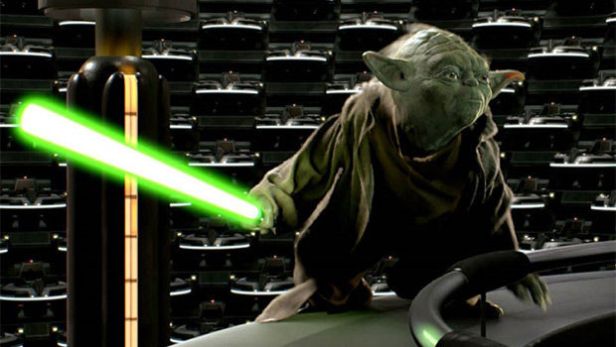 Now shit really hits the fan. The Jedi genocide gets underway, and Anakin/Darth Vader gets even more unhinged, like someone looking for his next hit of a drug. In many ways, he’s become addicted to the dark side, and shows characteristics of mental instability, and if George Lucas had really wanted to dig any deeper into the complexities of social taboos like addiction and mental illness, he certainly missed a big fucking opportunity.
Now shit really hits the fan. The Jedi genocide gets underway, and Anakin/Darth Vader gets even more unhinged, like someone looking for his next hit of a drug. In many ways, he’s become addicted to the dark side, and shows characteristics of mental instability, and if George Lucas had really wanted to dig any deeper into the complexities of social taboos like addiction and mental illness, he certainly missed a big fucking opportunity.
At this point, Revenge of the Sith becomes little more than back-to-back barrages of upsetting sequences: Jedi children slaughtered, Jedi Knights betrayed, Separatist leaders executed. I honestly don’t know why any of this is necessary. It’s gratuitous in every way, and, because Episode III tells you everything that’s going to happen before it happens, it’s redundant—yet no less graphic for its redundancy. It doesn’t illustrate anything we didn’t already know; moreover, it feels like filler material designed to build audience anticipation ahead of the Anakin/Obi-Wan duel that we know must eventually come. And perhaps most upsetting of all, these minutes of unending death and destruction all across the galaxy make Episode III into a Holocaust movie, and that’s something it never, ever needed to be.
♫ SPRINGTIME FOR VADER, AND PALPATINE… ♫
The movie does the Original Trilogy a disservice because it provides an explicit political mapping for the backstory. It’s the rise of the Third Reich, people, with some alterations. The Jedi are the Jews, the Roma, the gays; they’re different from everyone else, they’re sneaky, and they control everything, or seek to. At the same time they’re limited and weak, and by extension, they weaken the society of the Republic. This is a heavy burden to put on an operatic saga like Star Wars. In the Original Trilogy, mostly all we know is that there’s an Empire, and it’s evil because they go around extorting people and blowing shit up. We know that the Rebel Alliance fights to restore freedom to the galaxy. Exactly how this state of affairs arises never quite matters.
Even as it traffics in historical political allegory, Episode III flirts with the specter of modern politics as well. Palpatine tells Anakin earlier in the movie that he needs to “embrace a larger view of the Force, not just the dogmatic view of the Jedi,” echoing classic conservative rhetoric that aims to get listeners to accept a false equivalence between two arguments, as well as to suggest that any hint of impropriety on the part of the conservative speaker is surely the smear work of the liberal media. This is a decidedly contemporary political euphemism, and if there’s one thing I definitely don’t need, it’s to associate Star Wars with any particular political-historical era (it does, however, make for some excellent mashup comedy-analysis).
But back to the movie. Having refused to give up Anakin’s location to Obi-Wan, Padmé scurries off to Mustafar to warn Anakin that Obi-Wan will come after him. Obi-Wan, having anticipated—just like every damn person watching Revenge of the Sith—that she would do this, stows away on her ship. Padmé pleads with Anakin to leave it all behind, because that’s not cliché at all. Nope. She also tearfully informs him that he’s breaking her heart, in pretty much exactly those words. Because that’s not cliché either. Definitely not. And then Anakin sees Obi-Wan at the head of the ramp into the ship, and more shit that absolutely isn’t cliché, no way no how, ensues.
Then come the lightsaber duels, between Anakin and Obi-Wan, and Yoda and the Emperor, presented in parallel. These go beyond epic; they’re downright absurd. Meanwhile, the score goes all Carmina Burana and shit. Yoda fails to destroy the Emperor and declares his intention to go into exile (as opposed to…?). Obi-Wan defeats Anakin, cutting him off at the legs, and after Obi-Wan weeps over Anakin’s betrayal, what follows must claim the honor of Most Graphic Scene in the entire Star Wars saga. We, along with Obi-Wan, watch Anakin catch fire and get roasted alive. The camera is unflinching; it even seems to enjoy the moment. For all the shallowness of the rest of the Prequel Trilogy, this bit is actually fairly disturbing. It’s morbid. It’s voyeuristic. It’s satisfying, because Anakin’s been such a colossal whiny jackass, yet it’s also not, because in Star Wars, you don’t kill your mortal enemies; you merely wound them and then make a speech. It’s a little like watching a crucifixion. It’s been ten years since I first saw it, and I still don’t understand what’s going on here. Kenobi departs from Mustafar with Padmé as the Emperor arrives to save what’s left of Anakin, and at last we arrive at the epilogue of Revenge of the Sith.
There’s a picture that anyone who’s ever visited Greenwich, England takes. A line of brass inlaid into the concrete marks 0° of longitude; the meridian between the eastern and western hemispheres. One foot on the right-hand side; one foot on the left-hand side. This, my friends, this is Episode III, and more specifically its epilogue.
Episode III stumbles and lurches, a schizophrenic movie that can’t make up its mind about what it wants to do; it spends most of its time desperately trying to connect the dots to Episode IV, but it also expends considerable resources reminding the audience that Episodes I and II exist. It introduces the blockade runner, the very first ship we see in Episode IV. Blockade runners are boxy and geometric and about as aesthetically appealing as an Edsel. In other words, it’s completely out of place in the design aesthetic of the Prequel Trilogy, which featured a lot of sleek ships done up in chrome. It’s visually jarring even as it’s a naked attempt to connect the Prequel Trilogy to the Original Trilogy. The movie makes similarly self-conscious efforts to connect various fighters to the TIE fighters and X-wings that they become by the time Episode IV happens. And Episode III wasn’t by any means the only movie of the Prequel Trilogy that tried to establish its ties to the Original Trilogy. Star Destroyers began to creep in at the end of Episode II; so too did we catch our first glimpse of the future Death Star.
Revenge of the Sith looks ahead even to Return of the Jedi; in the sequence showing the massacre of Jedi at the hands of the clone soldiers, one shot shows a chase on speeder bikes that mimics the shot in Return of the Jedi in which Luke, on a speeder bike, falls back behind two Imperial troopers to shoot them down.
And yet through all of this desperate looking ahead, it doesn’t bother to fact-check itself: when Obi-Wan and Yoda replay holographic security recordings to find out who attacked the Jedi Temple, the recordings include an exchange between Palpatine and his new acolyte that we know to have taken place inside the Chancellor’s quarters, not the Jedi Temple. Lucas, get your damn facts straight.
The epilogue of Episode III has to do a lot, and it feels over-engineered; it has to get us from the world of the Prequel Trilogy to the world of the Original Trilogy. In heavy-handed fashion, it shows in parallel the final emergence of Darth Vader and the birth of Luke and Leia. It tries self-consciously to make the Prequels into a unified trilogy, which the Original Trilogy never did in such obvious ways. For example, it takes us back to Naboo for Padmé’s funeral, during which we get a glimpse of characters not seen since Episode I and we hear the same choral music that we heard during Qui-Gon Jinn’s cremation on Naboo some twenty-ish years earlier. That same theme gets composited with the Imperial March as we watch Darth Vader and the Emperor survey the beginning of construction on the Death Star. We briefly visit Alderaan so that we can hear Princess Leia’s theme, and end up on Tatooine outside the Lars moisture farm, where Obi-Wan hands off the infant Luke to the couple we know as Uncle Owen and Aunt Beru in A New Hope. In the final moments of the movie, it’s as if we’ve completely left behind the Prequels and returned to a digital reconstruction of 1977. It was a weird note to end on ten years ago, and it’s still hopelessly weird ten years later.
I wonder occasionally what would have happened had George Lucas restricted himself to the same technologies available to him during the production of the Original Trilogy. I think it fair to say that movie technology, and innovation therein, has of late become a goal as sought after as a commercially successful, well-received movie itself. Of Peter Jackson’s recent adaptation of The Hobbit we heard a great deal about its “groundbreaking” native 48fps (frames per second) shooting rate, a departure from the 24fps that has dominated the cinema industry for nearly a century. Following in the wake of Avatar, whose technical novelty has garnered no small number of column inches, movie after movie has jumped on the 3D bandwagon, with the result that 3D technology has increased the quality of the cinematic experience relatively little but ticket prices rather more than that. Thankfully, the 3D craze seems to have faded away, but it appears that the next thing already looms on the horizon—movies made for VR headsets.
I don’t hesitate to say that a big part of what lends Star Wars its particularly wonderful flavor owes to the fact that it came at a time when special effects technology really started to improve (of course, Star Wars itself contributed plenty to said improvement). There were still illusions to be MacGyvered, and you can see progress in the visual effects play out across the three films. It also meant that special effects didn’t—couldn’t—dominate the making of the movies. There had to exist something compelling in the story, in the dialogue, in the acting, because you couldn’t simply give the audience two hours of special effects-laden action sequences; it would have been prohibitively expensive. The Original Trilogy is, like any human artifact, a product of its time, and I think that part of its magic owes to the fact of its appearance in its particular time. Parts of the Original Trilogy are pretty hokey, and that’s okay.
The point is that we have arrived at a state wherein we can use the medium to sculpt the message; the choice of filmmaking technologies can have artistic merit of its own, and we now have the freedom to make that choice. Perhaps this practice exists in indie cinema, and perhaps some enterprising young film students out there come across old equipment and decide to set themselves a challenge. Mainstream cinema, on the other hand, arguably does not allow this kind of thing. For example, I can think of only two recent mainstream films that dared not to shoot in color: The Artist and Joss Whedon’s much-hyped Much Ado About Nothing. (Sidebar to the movie buffs: are these two movies even really mainstream?) (Editor’s Note: No.) As filmmaking technologies evolve, I think it only proper that a director should have the option to make the movie such that it appears as if it had been made in 1985.
Among all the things, I pine for the analog lightsaber. Digitally rotoscoped lightsabers look flat and lifeless, and their physics seems off, though perhaps my mind’s eye deceives me on the physics. One thing’s certain: there’s a lot more twirling of lightsabers in the Prequels, like batons in a marching band. The dueling style in the Original Trilogy reflects much more accurately the realities of swordfighting—you hack at your opponent and parry as best you can when he hacks at you. Here again the over-engineering of the Prequel Trilogy seems to come to the fore; no observant person will fail to notice that the lightsaber duels are a lot fancier in the Prequel Trilogy than they are in the Original Trilogy, and you can place yourself in the design meetings at ILM and hear them speculate that, with the fall of the Jedi order, the art of lightsaber dueling would have fallen from its golden age.
Speaking of things that have fallen from their peak, I also pine for John Williams’ musical style of the mid-’70s through the mid-’90s. I’ve made this point before, but it bears repeating. He never arrived at a convincing, memorable musical identity for the Prequel Trilogy, and what themes and cues he does reuse don’t come close to matching the style of the leitmotivs of the Original Trilogy; when he does introduce music from the Original Trilogy it sounds anachronistic.
Listen to the soundtrack of the original movies. I know we all think we know the themes, but the scoring for the Original Trilogy is nothing short of nonpareil. Leitmotivs are not just reused, they’re fragmented and transformed. When Williams does repeat music verbatim, he’s making a storytelling point. For example, the thematic material—down to the orchestration—is nearly identical between the scene showing Luke gazing into Tatooine’s twin sunset and Luke gazing into the cremation pyre of his father on Endor. It bookends the saga. It helps us contemplate Luke’s journey from naïve farm-boy to seasoned adult. That’s good goddamn storytelling. Yes, Return of the Jedi may be the most disjointed of the Original Trilogy, but the scoring for the two major death scenes—of Yoda, and of Darth Vader—is an absolute tour de force of Wagnerian operatic style. The moment after Darth Vader dies, we hear the Imperial March for the last time, but played on the harp, perhaps the most inappropriate instrument for that musical material. Yet it’s not inappropriate at all. The harp mimics bells tolling for the dead; it reflects the suddenly vanished power of the Empire. But it also helps to wrap up the storytelling in a way that the musical appearance of a version of Luke’s theme at the end of Revenge of the Sith doesn’t.
Despite the fact that I’ve spent the last five thousand words criticizing the Prequel Trilogy, I’m not here to say that George Lucas should never have tried to realize some of the Star Warsbackstory. What he did, though, was go too far. Peter Jackson, we could say, made the same mistake. He gave the world a magnificent set of movies in the Lord of the Rings trilogy, but his later trio of movies based on The Hobbit took the cinematic realization of Middle-Earth farther than it needed to go. The quality of the storytelling diminished rapidly, and each successive Hobbit movie met with more criticism than its predecessor. Simply put, both Lucas and Jackson made more movies than were really necessary.
The reality is, though, that we will probably continue to see new Star Wars movies until such time as Disney no longer feels that they’re profitable to make, and I can only wonder what the canon of Star Wars material will look like then. Canons have very much fallen out of favor. The typical contemporary discourse surrounding canons paints them as tools of exclusion, of privilege and power, and that by examining them through socioeconomic, racial, political, gender-oriented or sexual lenses, we can lay bare the ways in which canons work to uphold biases; we can expose their faults and therefore, by extension, argue for their overthrow. Canons tend, moreover, to define supporters in opposition to newness and change. Much of this is plenty accurate, and yet I still think it reasonable to exercise some restraint when it comes to the canon equivalent of iconoclasm. As I mentioned at the beginning of this re-view, I consider only the Original Trilogy to be canonical, and I have no compunctions whatsoever about defending this position, even if the amazing mind behind Machete Order doesn’t share in it.
I will reserve judgment of J.J. Abrams’ much-anticipated Episode VII until such time as I see the movie, although I must say—because, in the end, I can’t help myself—that I am already collectively embarrassed for Mark Hamill, Harrison Ford, and Carrie Fisher for appearing in it. Too harsh, you protest? Quit while you’re still ahead, I retort. At any rate, we’ll have to wait another seven months before we see what Abrams does in the sandbox that Star Wars has become. In the meantime, though, I’ll be busy standing on a sand dune, staring off into the sunset.
Free-Floating Thoughts
The effort to unify the Prequel Trilogy extends even to names, though here too George Lucas runs into inconsistencies. Consider the names given to the Sith lords of the Prequel Trilogy: Darth Sidious, Darth Plagueis, Darth Tyranus. All vaguely Latinate names. And then, Darth…Maul? Lucas has spent so much effort creating an identity for the Prequel Trilogy that when character names from the Original Trilogy come along—Darth Vader, namely—they seem out of place.
In Mace Windu’s duel with Palpatine, when he finally corners Palpatine on the ground, lightsaber aimed, who else wanted him to bust out with: “And I will strike down upon thee with great vengeance…”? C’mon, raise your hands.
Does anyone else wonder how the fuck the Force is out of balance if there are only ever two Sith in opposition to hundreds of Jedi? Just sayin’.
As bad as Episode III was, there was no Watto, and no Jar Jar Binks, and no referring to Anakin as “Annie.” Sometimes, it’s the little things.
Apparently Anakin Skywalker in Episode III has been referenced in clinical descriptions of borderline personality disorder. Because reasons.
During the writing of this re-view, I learned that the actor playing the original Emperor in The Empire Strikes Back—someone I had assumed for the last twenty years to be a man—is, in fact, a woman. HELL YEAH.

